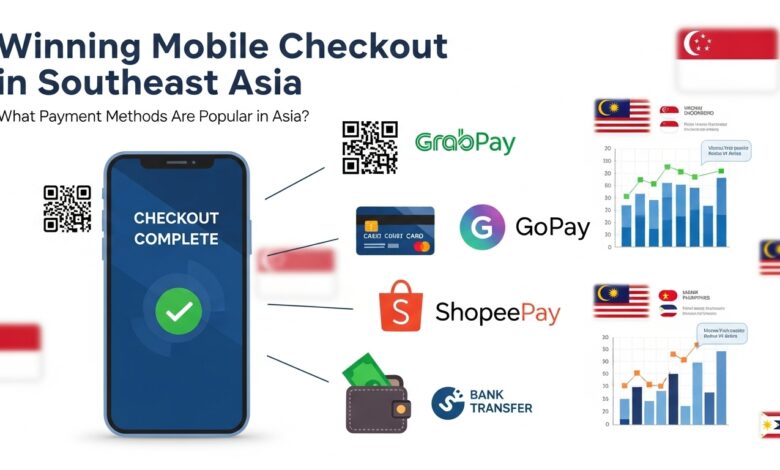Winning Mobile Checkout in Southeast Asia: What Payment Methods Are Popular in Asia?

You live in one of the world’s most mobile-first regions, where shoppers discover, evaluate, and pay on phones inside super apps and social streams. Yet conversion still leaks at the final step. The usual culprits are familiar: you don’t surface trusted local methods, you shoulder higher fraud and cross-border fees than you should, and your mobile payment sheet loads slowly or looks unfamiliar. Suppose you’re asking what payment methods are popular in Asia. In that case, the answer starts with how people actually pay on small screens—digital wallets, instant bank transfers, cards where they’re strong, COD where trust is still forming, and BNPL for flexible budgets. The faster you align your checkout with those everyday habits, the sooner you can cut drop-offs, protect margins, and win repeat purchases.
Scale across Markets with Local-First Payment Orchestration
If you sell across markets, your stack has to feel local in each one. That’s why many merchants evaluate providers with deep Asian coverage and orchestration tools—so you can switch on local wallets, bank rails, and risk controls without shipping a new integration for each market. In practice, this often means working with partners such as Antom (with coverage across mainstream wallets and bank transfers), Stripe, or Adyen. Your goal isn’t brand loyalty; it’s the ability to route intelligently, monitor performance per method, and optimize for mobile speed. If you need a single link to describe the concept, start with payment orchestration and map how it reduces retries, costs, and complexity as you expand your operations.
Consumer Behaviors Driving Mobile-First Shopping
Frequency and Categories
Mobile sessions now dominate product discovery and checkout across Southeast Asia. You see frequent, low‑friction purchases in fashion, beauty, convenience food, tickets, and digital goods. At the same time, larger baskets in electronics and travel still convert well on phones when payment choices feel familiar. The takeaway: assume your buyer will complete the entire journey in‑app, not merely discover and then move to desktop.
“What Payment Methods Are Popular in Asia” — Behavior Signals to Track
Shoppers pick what they already trust and recognize. In Southeast Asia, this typically means using a digital wallet daily, making a bank transfer through a real-time payment app, or scanning a QR code for in-store and online purchases. Cards still matter in some markets; COD remains relevant in specific categories and regions; and BNPL helps young or uncarded buyers manage cash flow. When you prioritize the methods your customers already have open on their phones, you lower friction and increase repeat purchases.
Payment Habits Shaping Mobile Checkout
Digital Wallets
Digital wallets are the default online method in much of the region—especially in Indonesia, Vietnam, and the Philippines. Wallet adoption continues to climb as super apps bundle shopping, delivery, and payments; QR code acceptance is now ubiquitous; and one-tap flows make repeat purchases effortless. For you, that means featuring the right wallet logos first, enabling save‑on‑file, and supporting instant refunds inside the same wallet.
Cards
Cards remain important, particularly in more mature environments, such as Singapore. There, credit cards play a larger role in e-commerce than in several of its neighboring, and tokenized, device-native experiences (stored card, biometric authentication) perform best. If cards are strong with your audience, lean into network tokens, clear SCA/3DS flows, and proactive retries to maintain high authorization rates on mobile networks.
Bank Transfer and Real‑Time Systems
Pay-by-bank is rising rapidly, driven by national instant-payment schemes (for example, PromptPay in Thailand and DuitNow in Malaysia), and is improving refund and reconciliation flows. In checkout, bank transfers can reduce the cost-to-pay on larger baskets and deliver strong success rates when you pre-fill details and return users seamlessly to your app. Pair this with real‑time payout capabilities for sellers and creators to complete the flywheel.
Cash on Delivery (COD)
COD still matters in some segments and geographies where trust, infrastructure, or access gaps persist. Offer it strategically—especially to first-time buyers or low-risk categories—then use post-purchase trust builders (such as fast delivery, easy returns, and clear refund timing) to encourage customers to transition to digital methods on their next order.
Buy Now, Pay Later (BNPL)
BNPL resonates with younger, often uncarded consumers across urban centers. Treat it as a targeted lever rather than a blanket default: highlight BNPL for discretionary categories and seasonal peaks, ensure transparent disclosures in‑flow, and monitor repayment outcomes to avoid downstream risk.
Merchant Acceptance Landscape
Acceptance has shifted toward local methods, including QR-based wallets, instant bank rails, and standardized cross-border QR linkages across ASEAN. That shift reduces reliance on cash for travelers and cross-border shoppers, making your checkout feel local to visitors from neighboring markets.
Cross‑Border Commerce in a Mobile‑First Region
Size and Momentum
Cross-border e-commerce continues to gain market share as platform logistics and payments mature. Region‑wide, digital payments already account for the vast majority of e‑commerce transactions and are on track to capture even more by 2028. The implication for you: if you localize methods upfront, you’re positioned to benefit from that step‑up in mobile spending.
Where Shoppers Buy From
Shoppers often spend more per order with overseas sellers, and smaller markets—especially Singapore and Malaysia—show higher cross-border penetration rates. If you’re inbound to SEA, lead with locally trusted methods for the destination market. If you’re outbound from SEA, ensure you support the preferred methods of your target buyers abroad.
Platform and Device Dynamics
Discovery, conversion, and service happen inside apps. That means your payment sheet must load in under a second on variable mobile networks, remember preferred methods, and display familiar brands first. For social commerce, prioritize deep links that drop shoppers straight into a pre-filled, one-tap confirmation.
Implications for Brands and Retailers
What Payment Methods Are Popular in Asia — a Clear Answer for Checkout
| Method | where it’s especially popular | What’s best for |
| Digital wallets & QR | Indonesia, Vietnam, Philippines; strong region‑wide | One‑tap in‑app payments, social commerce, repeat buys |
| Instant bank transfer | Thailand, Malaysia, Indonesia; expanding across SEA | Larger baskets, fee‑efficient payments, faster refunds |
| Cards | Singapore; urban, higher‑income segments | Subscriptions, travel, cross‑border with chargeback rights |
| COD | Select categories and regions | First‑time buyers, trust building |
| BNPL | Urban Gen‑Z/young professionals | Ticket‑size lift, conversion without cards |
Business Impact of Adding Locally Preferred Methods
- Higher conversion: Familiar, saved methods cut friction on mobile and reduce authentication failures.
- Bigger orders: BNPL can increase average order value in discretionary categories.
- Lower cost-to-pay: Account-to-account rails may reduce scheme and FX costs for certain flows.
- Better cross-border reach: Interoperable QR codes and local wallets enable travelers and cross-border shoppers to pay like locals.
Execution Challenges to Solve
- Fragmentation: Each market has distinct wallets, bank schemes, and rules—plan for method‑by‑method nuances.
- Fraud and risk: Cross-border flows increase exposure; utilize device signals, behavioral analytics, and strong authentication.
- Reconciliation and FX: Multiple providers create ops overhead; unify reporting and automate currency handling.
- Performance: Mobile users abandon slow or confusing sheets—optimize latency, fallbacks, and error states to improve user experience.
Localization Checklist for Mobile‑First Payment UX
- Lead with the likely top method (wallet/QR or bank transfer) based on device, locale, and past behavior.
- Use recognizable local brand marks and plain-language labels.
- Offer COD where it builds trust, then nudge to digital with incentives and clearer refund timelines.
- Optimize for real‑time rails and instant refunds where available.
- Implement guardrails for BNPL: transparent fees, soft credit checks, and clear limits.
- Unify routing and reporting through payment orchestration to manage methods, costs, and success rates across different markets.
- Measure what matters: method‑level auth rates, latency, drop‑offs, chargebacks—by OS, device, and network quality.
Conclusion
If you’re optimizing for Southeast Asia, the question of what payment methods are popular in Asia has a straightforward answer: digital wallets and QR codes, instant bank transfers, and—depending on the country and segment—cards, COD, and BNPL. You win when your mobile checkout looks and feels local, processes instantly, and removes anxiety around security and refunds. Start with the methods your customers already trust, layer in instant payouts and refunds where rails allow, and orchestrate the whole stack so you can adapt quickly as the region evolves.




